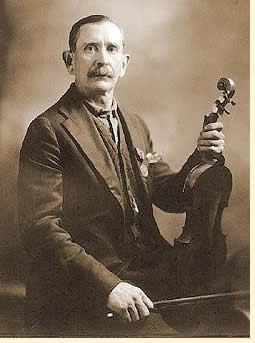Back to: Lesson Pack #1
- You must enroll in this course to access course content.
This tune has an accompaniment video. You can slow down or speed up any of the videos to make them more useful.
Lesson Three: Sail Away Ladies
Once again this next rhythm is syncopated and starts on the off beat before the first down beat. Or another way of thinking of it is that it starts when your foot is in the area before it comes to the ground on the down beat.
You can also think of this rhythm as long-long-short-short-long-long.
Be cautious not to shorten your long bow strokes (a common occurrence) instead exaggerate them and use as much of your bow as possible.
Sail Away Ladies
This version is recorded by Uncle Bunt Stephens 1926 in NYC for Columbia Records
Lyrics:
Ever I get my new house done, sail away ladies, Sail away
Give my old one to my son, Sail Away ladies, Sail away
Don’t she rock em, dai-dee-o, Don’t she rock, dai-dee-o
Don’t she rock, dai-dee-o, Sail Away Ladies, Sail Away
Ain’t no use to grieve and cry…
You’ll be an angel, bye and bye…
Come along, boys, and go with me…
We’ll go back to Tennessee…
Uncle Bunt Stephens
 John L. “Bunt” Stephens (1879-1951) was born in Bedford County, Tennessee. Both of his parents died while he was still a small child, and he was raised by an aunt who lived in the nearby community of Flatcreek.
John L. “Bunt” Stephens (1879-1951) was born in Bedford County, Tennessee. Both of his parents died while he was still a small child, and he was raised by an aunt who lived in the nearby community of Flatcreek.
“Bunt” was a self-taught musician. His first instrument was the harmonica, which he started playing at the age of six. When asked later in life how he began fiddling, he told a story of having bought a fiddle from a tramp for $25 when he was eleven. “He never took a lesson on the fiddle,” his son Haskell said; “he just took it up.” By the time “Bunt” was seventeen, he’d taught himself enough to play music at local square dances.
As an adult, “Uncle Bunt” moved to neighboring Moore County, where he farmed and worked in road construction, married, and raised five children. During this time, he continued to perform at nearby social events as often as his work allowed.
In 1926, when he was “a 47-year-old man who stood only five feet and weighed less than 120 pounds,” “Uncle Bunt” participated in a fiddling competition at the Lynchburg, Tennessee Ford dealership and won. He went on to win third prize in the statewide contest in Nashville and second prize in a regional contest in Kentucky. Finally, “Uncle Bunt” and the other regional champions were brought to Detroit, where they performed for Henry Ford, whose appreciation of old-time music had led him to sponsor this series of contests. Accounts differ as to whether Ford awarded “Uncle Bunt” the first-place blue ribbon or simply enjoyed the performance, praised the success of all the regional champions, and gave them gifts. Either way, “Bunt” became a sought-after performer and was often called the “World Champion Fiddler.”
:format(jpeg):mode_rgb():quality(90)/discogs-images/A-908702-1547954290-6753.png.jpg) After this dramatic success, “Uncle Bunt” began touring the eastern U.S. and performing onstage and on radio programs, represented by his former boss from the road construction crew. He traveled to New York with his second wife for a combined honeymoon and recording session, making the only known recordings of his music. Eventually he retired to his hometown and farm, where he lived a quiet life until his death in 1951.
After this dramatic success, “Uncle Bunt” began touring the eastern U.S. and performing onstage and on radio programs, represented by his former boss from the road construction crew. He traveled to New York with his second wife for a combined honeymoon and recording session, making the only known recordings of his music. Eventually he retired to his hometown and farm, where he lived a quiet life until his death in 1951.
Other tunes associated with this fiddler: Over the years, Stephens’ repertoire grew to include folk tunes such as “Sail Away Lady”, “The Arkansas Traveler“, and “Mississippi Sawyer.” Others included “Candy Girl”, “Left in the Dark Blues”, and “Louisburg Blues”, all of which he later recorded. His favorite tune was probably “Old Hen Cackled,” which is believed to have won him the blue ribbon at the Ford fiddlers’ contest in 1926.
Even after his death, “Uncle Bunt” was recognized as an influential and authentic fiddler. Some of his tunes were later included in the 1952 “Anthology of American Folk Music,” and at least one scholarly paper has analyzed his playing style (published in Ethnomusicology magazine in January 1968). His fiddling has been described as “rough-hewn but virtuosic” with “a rock steady beat,” and “probably similar to much American dance music in the period between the Revolutionary and Civil Wars.”
Additional Resources:
Bill Birchfield and the Roan Mountain Hilltoppers playing Sail Away Ladies.
Kenny Jackson plays Sail Away Ladies
Tommy Jarrell playing a different melody also called “Sail Away Ladies”
Strictly Strings plays Sail Away Ladies